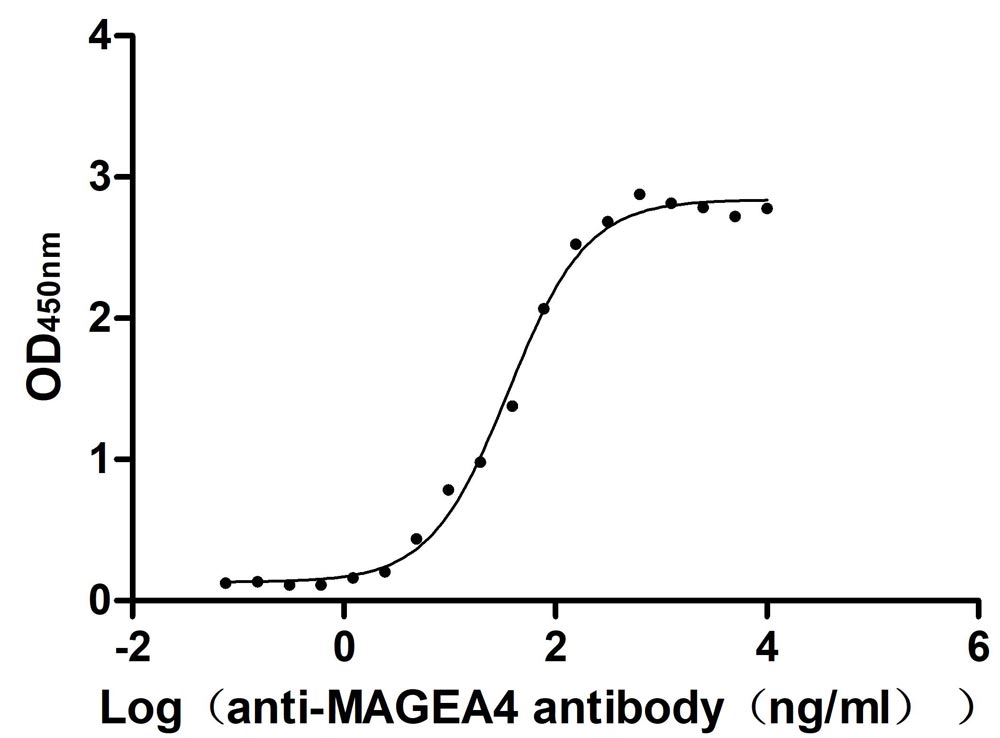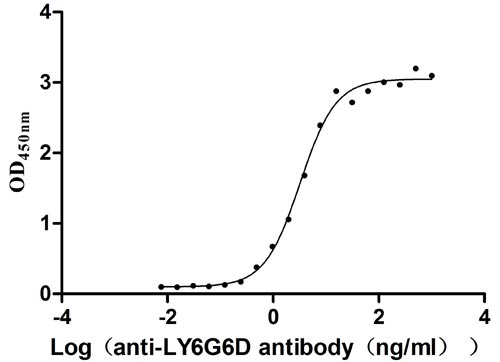Recombinant Mouse Protein phosphatase 1 regulatory subunit 15A (Ppp1r15a), partial
-
货号:CSB-YP018528MO
-
规格:
-
来源:Yeast
-
其他:
-
货号:CSB-EP018528MO
-
规格:
-
来源:E.coli
-
其他:
-
货号:CSB-EP018528MO-B
-
规格:
-
来源:E.coli
-
共轭:Avi-tag Biotinylated
E. coli biotin ligase (BirA) is highly specific in covalently attaching biotin to the 15 amino acid AviTag peptide. This recombinant protein was biotinylated in vivo by AviTag-BirA technology, which method is BriA catalyzes amide linkage between the biotin and the specific lysine of the AviTag.
-
其他:
-
货号:CSB-BP018528MO
-
规格:
-
来源:Baculovirus
-
其他:
-
货号:CSB-MP018528MO
-
规格:
-
来源:Mammalian cell
-
其他:
产品详情
-
纯度:>85% (SDS-PAGE)
-
基因名:
-
Uniprot No.:
-
别名:Ppp1r15a; Gadd34; Myd116Protein phosphatase 1 regulatory subunit 15A; Growth arrest and DNA damage-inducible protein GADD34; Myeloid differentiation primary response protein MyD116
-
种属:Mus musculus (Mouse)
-
蛋白长度:Partial
-
表达区域:40-657
-
氨基酸序列EVPEAWLAKTVTGADQIEAAALLTPTPVSGNLLPHGETEESGSPEQSQAAQRLCLVEAES SPPETWGLSNVDEYNAKPGQDDLREKEMERTAGKATLQPAGLQGADKRLGEVVAREEGVA EPAYPTSQLEGGPAENEEDGETVKTYQASAASIAPGYKPSTPVPFLGEAEHQATEEKGTE NKADPSNSPSSGSHSRAWEYYSREKPKQEGEAKVEAHRAGQGHPCRNAEAEEGGPETTFV CTGNAFLKAWVYRPGEDTEEEDNSDSDSAEEDTAQTGATPHTSAFLKAWVYRPGEDTEEE DSDSDSAEEDTAQTGATPHTSAFLKAWVYRPGEDTEEENSDLDSAEEDTAQTGATPHTSA FLKAWVYRPGEDTEEENSDLDSAEEDTAQTGATPHTSPFLKAWVYRPGEDTEDDTEEEED SENVAPGDSETADSSQSPCLQPQRCLPGEKTKGRGEEPPLFQVAFYLPGEKPESPWAAPK LPLRLQRRLRLFKAPTRDQDPEIPLKARKVHFAEKVTVHFLAVWAGPAQAARRGPWEQFA RDRSRFARRIAQAEEKLGPYLTPDSRARAWARLRNPSLPQSEPRSSSEATPLTQDVTTPS PLPSETPSPSLYLGGRRG
-
蛋白标签:Tag type will be determined during the manufacturing process.
The tag type will be determined during production process. If you have specified tag type, please tell us and we will develop the specified tag preferentially. -
产品提供形式:Lyophilized powder
Note: We will preferentially ship the format that we have in stock, however, if you have any special requirement for the format, please remark your requirement when placing the order, we will prepare according to your demand. -
复溶:We recommend that this vial be briefly centrifuged prior to opening to bring the contents to the bottom. Please reconstitute protein in deionized sterile water to a concentration of 0.1-1.0 mg/mL.We recommend to add 5-50% of glycerol (final concentration) and aliquot for long-term storage at -20℃/-80℃. Our default final concentration of glycerol is 50%. Customers could use it as reference.
-
储存条件:Store at -20°C/-80°C upon receipt, aliquoting is necessary for mutiple use. Avoid repeated freeze-thaw cycles.
-
保质期:The shelf life is related to many factors, storage state, buffer ingredients, storage temperature and the stability of the protein itself.
Generally, the shelf life of liquid form is 6 months at -20°C/-80°C. The shelf life of lyophilized form is 12 months at -20°C/-80°C. -
货期:Delivery time may differ from different purchasing way or location, please kindly consult your local distributors for specific delivery time.Note: All of our proteins are default shipped with normal blue ice packs, if you request to ship with dry ice, please communicate with us in advance and extra fees will be charged.
-
注意事项:Repeated freezing and thawing is not recommended. Store working aliquots at 4°C for up to one week.
-
Datasheet :Please contact us to get it.
靶点详情
-
功能:Recruits the serine/threonine-protein phosphatase PP1 to dephosphorylate the translation initiation factor eIF-2A/EIF2S1, thereby reversing the shut-off of protein synthesis initiated by stress-inducible kinases and facilitating recovery of cells from stress. Down-regulates the TGF-beta signaling pathway by promoting dephosphorylation of TGFB1 by PP1. May promote apoptosis by inducing TP53 phosphorylation on 'Ser-15'. In case of infection with vesicular stomatitis virus (VSV), impairs viral replication. ...显示更多
-
基因功能参考文献:
- Findings highlight that the phosphatase regulator, GADD34, also functions as a kinase scaffold in response to chronic oxidative stress and recruits CK1 and oxidized TDP-43 to facilitate its phosphorylation, as seen in TDP-43 proteinopathies. PMID: 29109149
- established Neuro2a cells with edited GADD34 and ATF4/GADD34 genes and found that ATF4 acts as a proapoptotic factor, but GADD34 depletion did not attenuate the expression of cleaved caspase-3 induced by tunicamycin treatment. PMID: 28825160
- In response to endoplasmic reticulum stress, activation of PERK coordinates the integrated stress response by phosphorylating eIF2alpha, which is then quickly dephosphorylated by the GADD34 complex. Data imply dual role of the ISR in promoting and inhibiting medulloblastoma tumorigenesis. PMID: 27802424
- GADD34 suppresses lipopolysaccharide-induced sepsis and tissue injury through the regulation of macrophage activation. PMID: 27171261
- Translation arrest is further demonstrated to be key for anti-viral response by acting synergistically with MAVS activation to amplify TBK1 signaling and IFN-beta mRNA transcription, while GADD34-dependent protein synthesis recovery contributes to the heterogeneous expression of interferon observed in dsRNA-activated cells. PMID: 28100675
- Results highlighted the essential roles played by GADD34 and CReP in regulating mRNA translation during unstressed conditions and following endoplasmic reticulum stress. PMID: 27161320
- Sustained protein synthesis sensitized cells to pharmacological induction of the Unfolded Protein Response (UPR), and the observed decrease in cell viability was restored upon inhibition of GADD34 activity. We conclude that NMP4 is a key regulator of ribosome biogenesis and the UPR, which together play a central role in determining cell viability during endoplasmic reticulum stress. PMID: 27129771
- Through aging or a high fat diet, insulin signaling in GADD34-deficient liver converted to be down regulated compared with WT mice. PMID: 26316333
- Results show that GADD34 plays a vital role in promoting cell death following proteasome inhibition via enhancing protein synthesis involved in endoplasmic reticulum stress, reactive oxygen species production and autophagy formation. PMID: 26408692
- avidity for the substrate plays an important role in imparting specificity on the PPP1R15B-PP1G-actin ternary complex. PMID: 25774600
- GADD34 enhances autophagy and suppresses apoptosis stimulated by LPS combined with amino acid deprivation through regulation of mTOR signaling pathway in macrophages. PMID: 25659802
- GADD34 upregulated pro-inflammatory mediator. PMID: 26196182
- GADD34 promotes cell survival and adaptation to increased extracellular osmolarity by increasing the uptake of small neutral amino acids via the amino acid transporter SNAT2. PMID: 26041779
- GADD34 expression was upregulated in the liver of mice after exposure to a carcinogen, diethylnitrosamine (DEN). In both acute and chronic DEN treatment models, GADD34 deficiency not only decreased oncogene expression, but also reduced hepatic damage. PMID: 25832002
- Thus these results indicate that GADD34 appears to suppress myofibroblast differentiation through inhibiting Smad3-dependent TGFbeta signal pathway and promote its apoptosis by activating caspase-3 pathway PMID: 25210702
- GADD34 works to inhibit the proliferation and differentiation of HSCs or myeloid precursor cells and maintains homeostatic differentiation of neutrophil-lineage cells to avoid early immunological senescence. PMID: 24247289
- Data indicate that GADD34 is the regulatory subunit of rotein phosphatase-1 (PP1) to specify PP1 to dephosphorylate TGF-beta-activated kinase 1 (TAK1) Ser412. PMID: 24534530
- Traumatic brain injury induces the expression of GADD34 by stimulating binding of a stress inducible transcription factor, ATF4, to the GADD34 promoter. PMID: 23907468
- GADD34 phosphorylation on tyrosine 262 modulates endoplasmic reticulum stress signaling and cell fate. PMID: 24092754
- Data indicate that ATF4/GADD34 and p90ATF6 expression gradually changed, and the levels of cleaved caspase-3 were significantly increased with repetitive cycles of testicular hyperthermia. PMID: 23611781
- study demonstrates that GADD34 is absolutely required for type I-IFN and IL-6 production by embryonic fibroblasts in response to dsRNA PMID: 22615568
- GADD34 was shown to be required for normal cytokine production both in vitro and in vivo. PMID: 22315398
- starvation-induced Gadd34 suppresses mTOR and, thereby, induces autophagy. PMID: 21439266
- GADD34 negatively regulates cell migration in wound healing via expression of myosin IIA. PMID: 20625881
- observations indicate that GADD34 controls a programmed shift from translational repression to stress-induced gene expression, and reconciles the apparent contradiction between the translational and transcriptional arms of cellular stress responses PMID: 12606582
- The function of GADD34 is a recovery from a shutoff of protein synthesis induced by endoplasmic reticulum stress. PMID: 12824288
- Results describe the effects of GADD34 on p53 phosphorylation and p21/WAF1 transcription. PMID: 14635196
- an equilibrium state exists between Gadd34 and the opposing heme-regulated inhibitor kinase EIF-2alpha during hemoglobin synthesis in the reticulocyte PMID: 16478986
- During conditions of cell stress, GADD34 forms a stable complex with tuberous sclerosis complex (TSC) 1/2, causes TSC2 dephosphorylation, and inhibits signaling by mammalian target of the rapamycin (mTOR). PMID: 17273797
- GADD34 contributes to the regulation of p21 expression, and it suppresses cellular proliferation through the induction of cellular senescence. PMID: 17487408
- GADD34 induced by VSV infection suppresses viral replication via mTOR pathway inhibition, indicating that cross talk between stress-inducible GADD34 and the mTOR signaling pathway plays a critical role in antiviral defense PMID: 17670836
- GADD34 gene restored virulence in HSV1716, suggesting that HSV virulence, rather than increased GADD34, exacerbated ischaemic damage. PMID: 17928799
- GADD34 translation is regulated by a unique 5'UTR uORF mechanism to ensure proper GADD34 expression during eIF2alpha phosphorylation PMID: 19131336
- Ppp1r15a mutant mice are superficially indistinguishable from wild type; Ppp1r15b(-/-) mouse embryos survive gestation but exhibit severe growth retardation and impaired erythropoiesis, and loss of both Ppp1r15 genes leads to early embryonic lethality PMID: 19181853
- The gadd34 and gadd153 proteins were localized in the nonepithelial cells and not induced in the cancer epithelial cells of the selenium-treated carcinomas. PMID: 19276161
收起更多
-
亚细胞定位:Endoplasmic reticulum membrane; Peripheral membrane protein; Cytoplasmic side. Mitochondrion outer membrane; Peripheral membrane protein; Cytoplasmic side.
-
蛋白家族:PPP1R15 family
-
组织特异性:Expressed strongly in spleen and lung, moderately in thymus and muscle, and weakly in brain.
-
数据库链接:
KEGG: mmu:17872
STRING: 10090.ENSMUSP00000049488
UniGene: Mm.4048


-AC1.jpg)

















